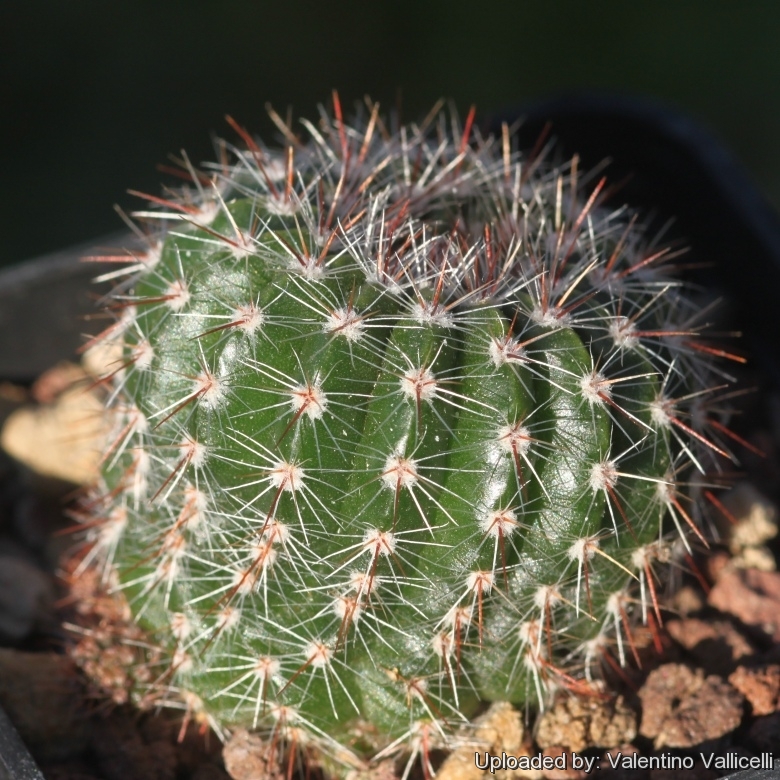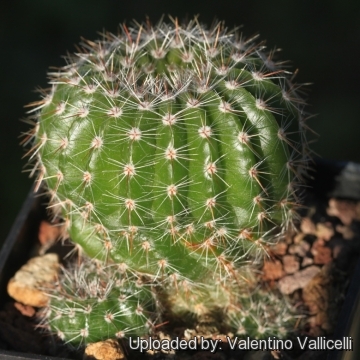Accepted Scientific Name: Parodia muricata (Otto ex Pfeiff.) Hofacker
Cactaceae Consensus Init. 6: 12. 1998

Notocactus apricus var. muricatus (Parodia muricata) Photo by: Valentino Vallicelli
Origin and Habitat: Parodia muricataSN|15592]]SN|15592]] has a small range in Rio Grande do Sul,Southern Brazil (extent of occurrence is 2,000 km2) and is not abundant.
Altitude: It grows at elevations of 300 to 700 metres above sea level.
Habitat and Ecology: Parodia muricataSN|15592]]SN|15592]] grows on rocky outcrops, in grasslands (pampas). The major threats are grazing, agriculture and introduction of exotic species, like pines which are planted at the side of the highway probably to reduced wind speed. The pine branches fall on the plants providing unnecessary shade and affecting flowering and seed dispersal.
Synonyms:
See all synonyms of Parodia muricata
back
Accepted name in llifle Database:Parodia muricata (Otto ex Pfeiff.) HofackerCactaceae Consensus Init. 6: 12. 1998Synonymy: 11
back
Common Names include:
RUSSIAN (Русский): Пародия коническая
Description: Parodia muricataSN|20445]]SN|15592]] (sometimes listed under its old name Notocactus muricatusSN|15599]]SN|15599]]) is a rare and poorly known species strictly related with Parodia carambeiensisSN|15592]]SN|20445]] that will flower early in its life.
Habit: Plants solitary or freely clustering.
Stems: At first globular, glaucous bright green, often depressed apically, but as with so many other Notocacti they become progressively more cylindrical as they grow older and can ultimately attain a height of 20 cm (or more) in cultivation and up to 20 cm in diameter.
Ribs: 16-20, obtuse, crenate, with wavy margins, dull, glaucous-green.
Areoles: Approximate.
Spines: Usually thin and delicate pale and spreading, rather weak to the touch.
Radial spines: 15-20, white to brown, hairlike, to 8 mm long.
Central spines: 3-4, darker than the radials brownish at tips, to 13 mm long.
Flowers: Yellow at the apex and large, up to 3 cm long; inner perianth-segments acute; style longer than the stamens; stigma-lobes 7 to 9, purple; scales of the pericarpels and floral tubes with wool and bristles.
Bibliography: Major references and further lectures
1) Curt Backeberg “Cactus Lexicon” Sterling Publishing Company, Incorporated, 1978
2) David Hunt, Nigel Taylor “The New Cactus Lexicon” DH Books, 2006
3) Edward Anderson “The Cactus family” Timber Press, Incorporated, 2001
4) James Cullen, Sabina G. Knees, H. Suzanne Cubey "The European Garden Flora Flowering Plants: A Manual for the Identification of Plants Cultivated in Europe, Both Out-of-Doors and Under Glass" Cambridge University Press, 11/Aug/2011
5) Larocca, J. & Machado, M. 2013. Parodia muricata. In: IUCN 2013. “IUCN Red List of Threatened Species.” Version 2013.2. <www.iucnredlist.org>. Downloaded on 12 February 2014.
6) N. L. Britton, I. N. Rose “The Cactaceae: Descriptions and Illustrations of Plants of the Cactus Family,” Volume 4 1922.
7) Walther Haage “Cacti and succulents: a practical handbook” Dutton, 1963
 Notocactus apricus var. muricatus (Parodia muricata) Photo by: Valentino Vallicelli
Notocactus apricus var. muricatus (Parodia muricata) Photo by: Valentino VallicelliSend a photo of this plant.The gallery now contains thousands of pictures, however it is possible to do even more. We are, of course, seeking photos of species not yet shown in the gallery but not only that, we are also looking for better pictures than those already present.
Read More... Cultivation and Propagation: It is relatively easy to grow on its own roots.
Soil: Grow it in an open sandy-gritty cactus compost.
Pots: It needs a relatively shallow pot to accommodate its fibrous roots and provide a very good drainage. It may stay in the same pot for many years.
Watering: Water in moderation, it prefer a completely dry place during winter. Mature individuals easily rot and die especially after planting so be extremely cautious with watering. Keep dry in winter or when night temperatures remain below 10° C. Water it less than average if in bigger pots.
Special need: Provide very good ventilation. Nearly all problems occur as a result of overwatering and poor ventilation, especially when weather conditions are dull and cool or very humid.
Fertilization: Feed them once during the growing season with a fertilizer specifically formulated for cactus and succulents (high potash fertilizer with a dilute low nitrogen), including all micro nutrients and trace elements diluted to ½ the strength recommended on the label. They thrive in poor soils and need a limited supplies of fertilizer to avoid the plants developing excess vegetation, which is easily attacked by fungal diseases.
Exposure: It will do its best with lots of sun and become stressed with inadequate light which could result in poor growth and unnatural shape.
Hardiness: It likes warmth (recommended minimum winter temperature 5° C) however plants kept perfectly dry can can survive low temperatures, approx. -5°, but for safe cultivation it is best to avoid freezing temperatures.
Use: This is a good pot plant suited for a non heated green house. It can be also cultivated outdoors in raised beds, terraces if sheltered from winter rain. This cactus continues to be, a particular prize among collectors
Pests & diseases: These cacti may be attractive to a variety of insects, but plants in good condition should be nearly pest-free, particularly if they are grown in a mineral potting-mix, with good exposure and ventilation. Nonetheless, there are several pests to watch for:
- Red spiders: Red spiders may be effectively rubbed up by misting the plants from above.
- Mealy bugs: Mealy bugs occasionally they develop aerial into the new leaves and flowers with disfiguring results, but the worst types develop underground on the roots and are invisible except by their effects.
- Rot: Rot is only a minor problem if the plants are watered and “aired” correctly. If they are not, fungicides won't help all that much.
Propagation: Seeds. The seeds can be sown in pots of fine, well-drained sandy soil, any time during the spring when temperatures are warm. Cover the seeds with a fine layer of grit and water from below with a fungicide to prevent damping off. For the 1-2 weeks cover the pots with a sheet of glass/clear perspex to keep the humidity levels high. Remove the glass and replace it with light shade-cloth and mist once or twice a day for the next two weeks after which most seeds should have germinated. From then on mistings can be reduced to every second and then every third day as the little plants grow.











